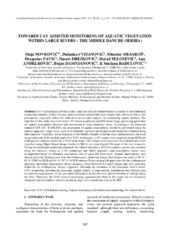Приказ основних података о документу
Towards UAV Assisted Monitoring Of An Aquatic Vegetation Within The Large Rivers – The Middle Danube
| dc.creator | Novković, Maja | |
| dc.creator | Cvijanović, Dušanka | |
| dc.creator | Minučer, Mesaroš | |
| dc.creator | Pavić, Dragoslav | |
| dc.creator | Drešković, Nusret | |
| dc.creator | Milošević, Đurađ | |
| dc.creator | Anđelković, Ana | |
| dc.creator | Damnjanović, Bojan | |
| dc.creator | Radulović, Snežana | |
| dc.date.accessioned | 2023-10-12T07:54:57Z | |
| dc.date.available | 2023-10-12T07:54:57Z | |
| dc.date.issued | 2023 | |
| dc.identifier.issn | 1842 - 4090 | |
| dc.identifier.issn | 1844 - 489X | |
| dc.identifier.uri | https://plantarum.izbis.bg.ac.rs/handle/123456789/1151 | |
| dc.description.abstract | UAV technologies provide a time- and cost-efficient framework for a variety of environmental monitoring domains. It also increases data resolution and provides new insights into observed objects and phenomena, especially within the difficult-to-access and complex for monitoring aquatic habitats. The objective of this study was to develop UAV-based acquisition and GIS-based image processing guidelines for aquatic macrophyte detection and monitoring in large temperate rivers. According to the European standard CEN EN -14184:2014, the assessment of aquatic macrophytes should be performed using the transect approach. Large rivers, such as the Danube, represent an exception and should be evaluated using 1km transects. Therefore, seven transects of the Middle Danube in Serbia were simultaneously surveyed using traditional field methods and novel UAV technology. UAV images were acquired using RGB and multispectral cameras carried by a fixed-wing drone. The images were processed and orthomosaics were classified using Object Based Image Analysis (OBIA), to create digital GIS maps of the river transects. During the traditional monitoring approach, the relative abundance of 22 macrophyte species was recorded along the transects. Using the UAV technology and OBIA approach eight macrophyte classes were distinguished based on dominant macrophyte taxa or plant life form traits. Aquatic macrophytes were 'almost perfectly' distinguished from the orthomosaics, achieving a high classification accuracy of 96 % / 88 % / 0.84 for RGB and 94 % / 97 % / 0.95 Producers /Users accuracy/Kappa index for the multispectral approach. Individual macrophyte classes accuracy varied between 0.5 and 1 Kappa and were generally higher for the multispectral imagery approach. Although the resolution of the taxonomic data is lower, UAV monitoring provided the necessary spatial context of macrophytes distribution and absolute area occupied by macrophytes. It also provided information on the diversity and distribution of habitats along the river. Therefore, the UAV-assisted monitoring approach described in this study can be effectively integrated into macrophyte monitoring during large river expeditions such as the JDS. | sr |
| dc.language.iso | en | sr |
| dc.publisher | Carpathian Association of Environment and Earth Sciences | sr |
| dc.relation | info:eu-repo/grantAgreement/MESTD/inst-2020/200125/RS// | sr |
| dc.relation | Rufford grant No 28388-1 | sr |
| dc.relation | project of Provincial Secretariat for Higher Education and Scientific Research, Autonomous Province of Vojvodina, Republic of Serbia, no 142-451-2095/2022-01 | sr |
| dc.rights | openAccess | sr |
| dc.rights.uri | https://creativecommons.org/licenses/by/4.0/ | |
| dc.source | Carpathian Journal of Earth and Environmental Sciences | sr |
| dc.subject | UAV | sr |
| dc.subject | GIS | sr |
| dc.subject | Remote sensing | sr |
| dc.subject | Aquatic macrophytes | sr |
| dc.subject | Environmental monitoring | sr |
| dc.subject | The Danube River | sr |
| dc.title | Towards UAV Assisted Monitoring Of An Aquatic Vegetation Within The Large Rivers – The Middle Danube | sr |
| dc.type | article | sr |
| dc.rights.license | BY | sr |
| dc.citation.epage | 322 | |
| dc.citation.issue | 2 | |
| dc.citation.spage | 307 | |
| dc.citation.volume | 18 | |
| dc.type.version | publishedVersion | sr |
| dc.identifier.doi | 10.26471/cjees/2023/018/261 | |
| dc.identifier.fulltext | http://plantarum.izbis.bg.ac.rs/bitstream/id/3676/Novkovic_etal_2023_M23.pdf |


